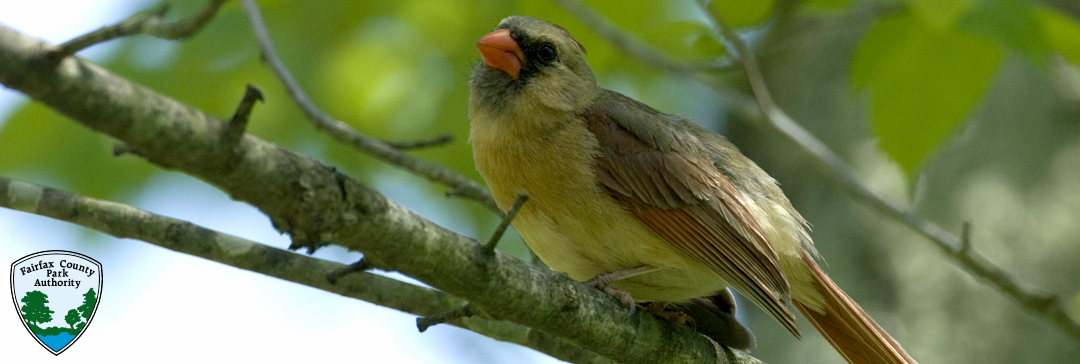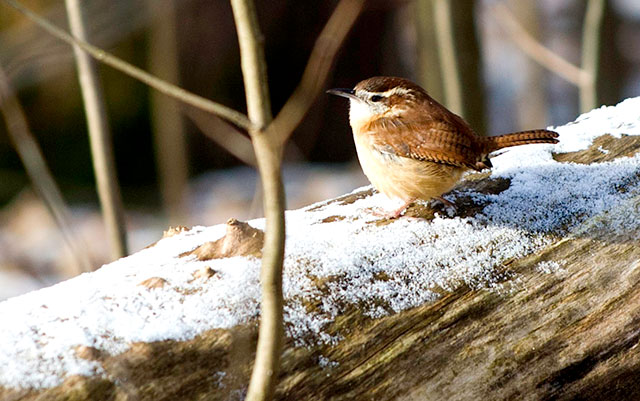
Alert:



| Activity Name | Place | Start Date | Schedule | Price | Learn More |
|---|---|---|---|---|---|
| Winter Bird Walk | Burke Lake Park | Jan. 28 | 9-10 a.m. | $8 | Learn More |
| Home Made Bird Feeders | Burke Lake Park | Feb. 3 | 11 a.m.-noon | $8 | Learn More |
|
Birding at Huntley |
Huntley Meadows Park |
Feb. 7 |
8-11 a.m. |
$19 |
Learn More |
| Make Your Own Pinecone Birdfeeders! | Lake Accotink Park | Feb. 17 | 1:30 - 2:30 p.m. | $10 | Learn More |
| Winter Bird Walk | Lake Accotink Park | Feb. 9 | 4-5 p.m. | $8 | Learn More |
| Winter Bird Walk | Ellanor C. Lawrence Park | Feb. 17 | 1-2 p.m. | $8 | Learn More |
| Home Made Bird Feeders | Ellanor C. Lawrence Park | Feb. 18 | 2-3 p.m. | $8 | Learn More |
|
Birding for Beginners (12-Adult) |
Huntley Meadows Park |
Feb. 25 |
8-11 a.m. |
$19 |
Learn More |
The Fairfax County Park Authority’s land is home to countless birds. More than 190 species of birds have been seen in or from Riverbend Park. More than 130 have been documented in Ellanor C. Lawrence Park. Lake Accotink has secret marshes that draw waterfowl. Riverbend and Lake Fairfax attract migrating waterfowl. Burke Lake is large enough for loons to take flight. More than 200 bird species have been identified in the wetlands of Huntley Meadows Park.
Each species of bird is attracted to particular habitat, and Fairfax County park habitats include woods, wetland, river, and lake environments that attract a broad range of species. Lake parks, Riverbend and Huntley Meadows are routine stopping points for migrating birds. Smaller lake parks, like Lake Mercer, appeal to large numbers of birds, especially in late winter if freezing temperatures play havoc with the water’s shad population. Even Hidden Pond Nature Center, smack in the middle of Springfield, is an excellent birdwatching spot because of the feeder that hangs just outside a large viewing window in the nature center.

Birds are celebrated throughout the world in many ways. Whether it’s a bird count, World Bird Day, or National Bird Month, Fairfax County Park Authority welcomes birds every day in our parks. Here are some upcoming, festive days and months in 2023 to observe birds of all kinds.
Get the whole family involved and create a habitat for birds with these hands-on activities.
Help birds by providing them food or nesting materials. For both activities, use a pinecone. Tie a piece of 12 inches of yarn on the base of the pinecone. For food, smear vegetable shortening on the pinecone and then shake the cone in a lunch bag filled with 1 cup of bird seed. Hang the pinecone feeder outside. For nesting materials, stuff in the pinecone small pieces of yarn and raffia or grasses, cotton balls, small pieces of cloth. Hang out in early spring for birds to collect nesting materials. Check your bushes in late summer to see if any birds feathered their now-abandoned nests with your materials!
Want more birds in your yard? Native plants are a wonderful addition to your landscaping and provide much needed nutrients to birds. Learn how to attract a variety of birds with natural plantings.
It’s winter and that means in addition to snow, you may observe the “Snow Bird,” a nickname given to the Dark Eyed Junco because of its white belly. This is a very common bird you will see at your feeder in winter! The Junco is a medium-sized sparrow with a rounded head, a short, stout bill and a fairly long tail. You will find Dark-eyed Juncos on the ground. They hop around looking for food. You’ll often hear their high chip when you are outdoors. The Dark-eyed Junco is a welcome winter visitor; they appear as winter sets in, and then retreat northward each spring.
Want to know what birds live in Fairfax County? This Field Guide will come in handy and help you identify birds that you may not be familiar with. Put your observation skills to work as you brush up on your birding skills.
Did you know that there are six species of woodpeckers living in our community? Woodpeckers do not eat wood, but rather are in search of food within the trees. Explore woodpeckers and their amazing “shock absorption” and entertaining sounds in this article.
